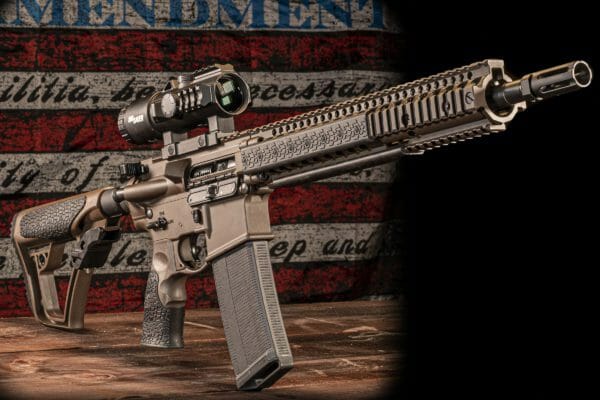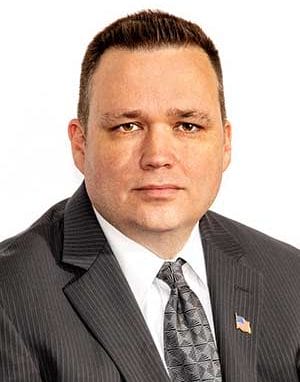https://www.ammoland.com/wp-content/uploads/2021/12/Daniel-Defense-HERO-01-500×333.jpg

A United States Federal District Court Judge for the District of Kansas dismissed a case against a man accused of having two machine guns, claiming that these firearms are protected as bearable arms under the Second Amendment.
Prosecutors claim that on Oct. 17, 2022, Tamori Morgan possessed two machine guns. The first firearm was an Anderson Manufacturing AM-15 chambered in .300 blk that the man converted from semi-automatic to fully automatic. The second machine gun was a Glock 33 equipped with a Glock switch. A Glock switch converts a semi-automatic handgun to a machine gun. These switches are readily available on Chinese websites, and their numbers in the country have risen over the past few years.
In April 2023, a grand jury in the U.S. District Court in Wichita, Kansas, indicted Morgan for possession of the two machine guns. Mr. Morgan would be assigned federal public defender David Freund. Public defenders get a bad rap, but these are some of the most experienced trial lawyers in the country. Mr. Freund filed for a motion to dismiss in November of 2023, claiming that machine guns were protected arms under the Second Amendment.
Under the Bruen test, a law on guns is only constitutional if it is consistent with the text, tradition, and history of the Second Amendment. The first step is the original text of the Second Amendment. There is nothing in the Second Amendment that gives the government the right to ban machine guns. Once it is determined that a law isn’t consistent with the text, the burden falls to the government to provide historical analogues to show that the law is consistent with the history and tradition of the Second Amendment from the founding era.
“When the Second Amendment’s plain text covers an individual’s conduct, the Constitution presumptively protects that conduct,” Associate Justice Clarence Thomas wrote in Bruen. “The government must then justify its regulation by demonstrating that it is consistent with the Nation’s historical tradition of firearm regulation. Only then may a court conclude that the individual’s conduct falls outside the Second Amendment’s unqualified command.”
The government tried to argue that the Second Amendment only applies to arms that were around during the ratification of the Second Amendment. U.S. District Judge John Broomes rejected Assistant U.S. Attorney Aaron Smith’s arguments. The prosecutor also tried to use English common law. Prosecution also mentioned a case from North Carolina in 1829 that recognized an offense to arm oneself “with dangerous and unusual weapons, in such a manner as will naturally cause a terror to the people.” The judge dismissed both laws because they were not similar to the charges against Morgan. The Supreme Court’s Rahimi opinion said that an analogue doesn’t have to be a “historical twin.” SCOTUS went on to say it does have to resemble the law being defended.
The judge also called out the prosecutor for trying to use dicta from the Heller decision. Mr. Smith attempted to say that Heller allowed for banning machine guns because they are “dangerous and unusual.” The judge was quick to reject the argument because the Heller case had nothing to do with machine guns. He also pointed out that not all machine guns are illegal; only ones produced after May 1986 are forbidden for public transfer. Judge Broomes highlighted that there are 740,000 transferable machine guns in public circulation.
“Machineguns have been in existence for well over a century,” the judge wrote. “While the federal government has regulated transfer and possession of such weapons since passage of the National Firearms Act in 1934, it did not outright prohibit possession of machineguns until passage of the Firearms Owners Protection Act in 1986. Even then, the law did not prohibit the possession of all machineguns; rather, § 922(o) merely prohibits possession of machineguns that were not lawfully possessed as of the date that prohibition went into effect in 1986. § 922(o)(2)(B). Thus, even today, it is perfectly legal for a person who has not been divested of his firearm rights under some other provision of law to acquire and possess a machinegun, so long as it was lawfully possessed by someone before the relevant date in 1986, and so long as he complies with the National Firearms Act’s requirements to obtain and possess the weapon. In that sense, machineguns are not unusual.”
The government then tried to say the law was justified because machine guns were “military weapons.” To counter this point, the judge used United States v. Miller. In the 1939 Miller case, the Supreme Court rejected the idea that sawed-off shotguns were protected arms and couldn’t be regulated. The Supreme Court reasoned that sawed-off shotguns were not used on the battlefield and, therefore, not protected. The Supreme Court believed that the Second Amendment applied to military arms. The judge also highlighted laws from the founding era that required civilians to keep personal military arms in case the need arose for a militia to be formed.
The judge dismissed the case, but the prosecutor can appeal the judge’s decision. Most legal experts expect this appeal. The decision doesn’t knock down the National Firearms Act of 1934 (NFA) and doesn’t apply to anyone outside the case. Post-1986 machine guns remain illegal to own for private citizens. Mr. Morgan faced ten years in prison and a $250,000 fine for each offense if convicted.
About John Crump
Mr. Crump is an NRA instructor and a constitutional activist. John has written about firearms, interviewed people from all walks of life, and on the Constitution. John lives in Northern Virginia with his wife and sons, follow him on X at @crumpyss, or at www.crumpy.com.

AmmoLand Shooting Sports News